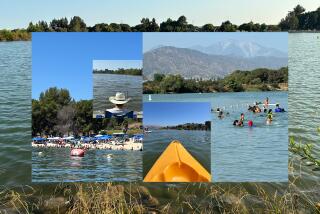Taming Big Cats by Boat : Irvine Lake Boasts a Lunker Variety of Whiskered Fish
- Share via
All is quiet on the water, the crowd having already called it a day. The wind has settled to a zephyr, the birds have gone to roost and the sun has dropped below the horizon.
But Irvine Lake is anything but calm.
“When it’s like this, it’s hot,” lake Manager Bennett Davison says of fishing at the Orange County reservoir.
Davison should know. In the last three years he has spent more time on the lake than many of the fish have in it--most under the cover of darkness.
He tells of the raccoon that visits the lake after sunset, of the coyotes that sneak to the water’s edge to hunt and drink, of the deer that prefer dusk to daylight. He recalls the time a mountain lion scampered across the dam, silhouetted against the moon, while Davison watched from his boat, a mere stone’s throw away.
But the wildlife around the water doesn’t interest Davison nearly as much as that living in it. When stars twinkle and moonlight dances on the water, chances are Bennett Davison will be hunting catfish somewhere on Irvine Lake. And more than likely, he will find catfish chasing threadfin shad on the surface.
“You better believe it,” Davison says as he motors his pontoon boat, loaded with rods and reels and a bucket of freshly cut mackerel, toward the dam. “Most people go out (for) catfish and sit and fish for them. I call it catfish hunting because they’re on the surface, and I won’t cast until I see one boil.”
Davison cuts the engine and silence falls over the area. Cool air flows through the valleys and canyons that surround the lake. Rolling green hills fade into darkness.
Davison, 26, tells of the hundreds of catfish he has landed--and of the time he was drift-fishing one cold and rainy night last February when a monster catfish took him for a ride.
“It was like a submarine,” he says. “It towed the boat 30 feet this way, then it came back around, took me back around the boat. . . . It took me back and forth three or four times.”
The fish eventually surfaced and rolled over on its side.
“I knew then it was definitely 30-pounds-plus,” Davison recalls. “It came to the boat, but then it started blistering me. My eight-foot rod just doubled over.”
After about 25 minutes the fish could struggle no more and was brought up alongside the boat.
“We netted it and right then the line snapped,” Davison says. “It took two people to lift (onto the boat).”
It was a blue catfish measuring 3 1/2 feet and weighing 49 1/2 pounds. Its “whiskers” were a foot long on either side of its face.
“I’d been hit by big ones before but never landed them,” Davison says. “They just smoked me.”
Suddenly, a swirling splash off in the distance removes all doubt that such fish do indeed exist in Irvine Lake.
“Twenty pounds, easy,” Davison says, adding that the fish is too far away to try for. “They’ll get (closer). . . . Hang tight.”
Another large catfish breaks the surface nearby, and another.
“If you hit those first boils . . ,” Davison says, heaving a chunk of mackerel in the direction of one. No takers. Another splash, another cast. Nothing.
Davison, eager to put fish on the boat and make good guarantees, decides to forgo the “hunt” and revert to the traditional method--casting and waiting.
He pulls to within casting distance of the shoreline and instructs the passengers to try an area near the bank.
“They won’t be the big ones, but there’ll be plenty of them,” he says.
Should there be a tug on the line, let the fish take it for a few seconds and then set the hook, Davison says.
“And when you go to set the hook, flip the bail over and rip into him,” he says. “If you get a pair of lips, you get lips.”
Catfish are indeed thick at this far corner of the lake, where a tug is felt on almost every cast, but several are lost in the underwater brush.
Rather than allow the few extra seconds, Davison rears back on the rod within an instant of the next tug on his line. A few short pumps and the fish is free of the brush and struggling in the open water. Moments later Davison bounces the first fish onto the deck, a three-pound catfish with lips intact.
The action continues steadily, the fish showing surprising spirit on the light-tackle rods. Soon, more than a dozen catfish--between two and six pounds each--cover the deck of Davison’s boat. Several more are released. Bigger fish continue to splash in the distance, but Davison’s mackerel bucket is empty. He decides to call it a night.
Catfish season has begun in Southern California, and although the fish aren’t much to look at, with their rubber-like skin and prehistoric facial protrusions, they have a following. And those doing the following have found Irvine Lake to be one of the most productive fisheries in the country.
The reservoir--which supplies drinking and agricultural water to the area--was developed in 1931 and opened to fishing in 1942. Since then, the nutrient-rich fishery has thrived on every level of the food chain--and word has spread of the giant catfish there.
On a given summer night--the lake is open until 11 p.m. Thursday through Saturday--there will be more than 100 anglers on the lake in search of a monster of their own.
“A 20-pounder is commonplace,” says Dick Gaumer, 55, a light-tackle specialist who does marketing work for Irvine and the nearby Santa Ana River Lakes. “Not even worth taking pictures of.”
Gaumer adds that the primary reason Irvine’s catfish grow so large is the lake’s tremendous population of threadfin shad, on which the catfish feed.
Davison says that what separates Irvine’s catfish fishery from others is that most of the thousands of oversized rainbow trout the lake stocks during the winter can’t survive the warm water of summer.
“If our trout die off every year when the water gets warm, these catfish have some good trout eating for quite a few months,” he says. “We had big cats in before, and they’ve stocked trout here for years, but (with) the number of trout we put in now . . . dynamite!”
The legendary Jimmy Houston, the traveling fisherman/film maker, paid a visit a few years back and left with a 46-pound 2-ounce catfish and memories of an even bigger one that got away because he had no net. He was convinced that Irvine Lake ranks with the best when it comes to catfish.
“There are several places in the United States, and in particular, Canada, that have unbelievable channel catfish fisheries, and he considered this one of the very best,” Gaumer says.
Davison’s 49 1/2-pound blue catfish does fall short of the state-record 59-pound 4-ounce blue, but the record fish was also pulled out of Irvine Lake. And so was the state-record channel cat, at 48-8.
Irvine has yet to produce a catfish close to the size of the all-tackle world-record 97-pound blue catfish, taken from a South Dakota section of the Missouri River, but those familiar with the lake insist that it contains some very large fish.
Biologists from the Department of Fish and Game once examined the fishery and concluded that it held a number of catfish in excess of 70 pounds.
Fishermen tell of being towed across the lake and losing their fish after lengthy battles. Gaumer once hooked into a catfish while fishing with six-pound test for bass and fought it for more than an hour before losing it.
“They’re never landed because . . . Do you know what it would be like to land a 70-pound catfish?” he asks.
Somebody might soon find out.
More to Read
Sign up for Essential California
The most important California stories and recommendations in your inbox every morning.
You may occasionally receive promotional content from the Los Angeles Times.










